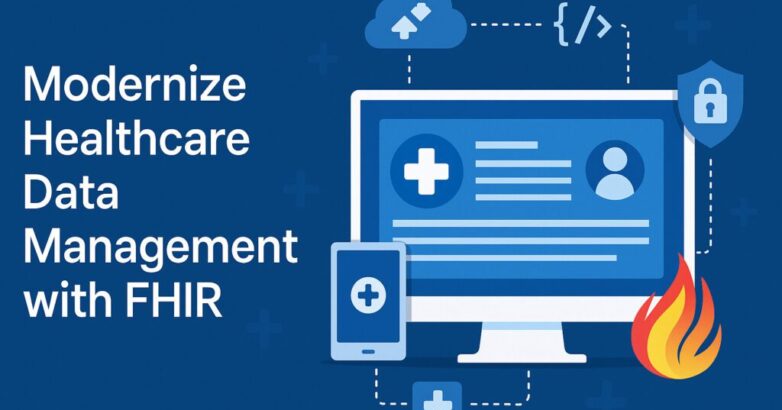The HL7 Fast Healthcare Interoperability Resources (FHIR) standard is transforming how healthcare organizations manage, move, and exchange data across modern systems.
While digital technologies have simplified data management, healthcare interoperability has often lagged behind due to the sensitivity and complexity of medical information.
For example, many healthcare organizations still rely on fax machines for data exchange — a dated practice that limits coordination, analytics, and cost efficiency.
FHIR APIs solve this by defining how data should flow across systems, enabling seamless EHR integration and driving digital health transformation.
FHIR is built on “resources”— modular data units that can be combined to meet business needs. By leveraging these resources, healthcare organizations can enable smart data management, improve collaboration, and enhance patient outcomes.
Why FHIR Matters for Modern Healthcare Organizations
Below are four key reasons FHIR is essential for healthcare data modernization — along with its challenges, best practices, and opportunities for innovation.
1. Developer-, Device-, and REST-Friendly Data Management
FHIR is open-source, flexible, and free to implement, making it easy for organizations to customize and scale as they grow.
Its use of familiar web standards like HTTPS, XML, REST, OAuth, and JSON makes onboarding developers faster and more cost-effective.
Key benefits include:
- Rapid interface setup — sometimes in a single day
- Scalability for future growth
- Simplified app development with open libraries and tools
FHIR’s compatibility also makes it ideal for mobile health applications. REST APIs allow secure, real-time data sharing through wearables and apps.
Imagine remote monitoring, instant access to patient records, or telehealth sessions that automatically sync with centralized EHR systems.
These use cases highlight how FHIR empowers proactive, patient-centered care.
2. No Vendor Lock-In for Healthcare Providers
Traditionally, healthcare providers were constrained by proprietary EHR systems that made integration and innovation costly.
FHIR’s vendor-neutral design changes that paradigm.
With initiatives like the Argonaut Project, industry leaders are working together to create interoperable standards across healthcare platforms.
This ensures systems can communicate seamlessly, giving providers freedom, flexibility, and innovation control.
When comparing FHIR vs. legacy systems, the difference is clear:
- No vendor restrictions
- Easier system migrations
- Lower costs and higher adaptability
By removing vendor dependencies, FHIR enables digital health transformation at scale and pace.
3. Enhancing Care Quality and Reducing Costs
One of FHIR’s biggest strengths is data unification.
It integrates information from IoT devices, wearables, medical equipment, and mobile apps into one consolidated patient record.
This unified view empowers:
- More accurate diagnoses
- Stronger care coordination
- Improved clinical outcomes
From a cost perspective, FHIR reduces duplication and administrative overhead, making IT environments more efficient and affordable.
For patients, it means personalized care and consistent experiences across multiple providers.
At the population level, Bulk FHIR APIs allow organizations to analyze massive datasets for risk identification, trend monitoring, and preventive care strategies — critical for public health and chronic disease management.
4. Simplifying Implementation with the Right Partner
Despite its advantages, FHIR implementation challenges can arise — especially when integrating with legacy systems or meeting compliance standards.
Many organizations also struggle to transition from HL7 v2 to FHIR while maintaining daily operations.
Key challenges include:
- Complex technical integration
- Compliance and data privacy alignment
- Limited staff expertise
To address these, the Prolifics Innovation Center developed Prolifics Quick FHIR — a solution that accelerates FHIR adoption with minimal IT disruption.
Built on IBM software and proprietary IP, Quick FHIR removes the need for organizations to purchase or integrate multiple tools.
It reduces time-to-value, implementation costs, and overall complexity.
About the Prolifics Innovation Center
The Prolifics Innovation Center combines deep industry expertise and proven methodologies to help healthcare organizations modernize confidently.
Our specialists collaborate closely with clients to deliver customized FHIR solutions that address real-world business and clinical needs.
If you’d like to learn more about Prolifics Quick FHIR or explore partnership opportunities, reach us at solutions@prolificsdev.wpengine.com
About the Author
Matt Garst, Head of Sales for Digital Automation and Cloud Solutions at Prolifics, has over 20 years of IT industry experience.
He previously managed IBM’s software business within the U.S. Army and Missile Defense Agency and led global sales teams for enterprise information management.
A former U.S. Army Infantry soldier, Matt brings a unique blend of discipline, leadership, and innovation to his role in advancing healthcare technology.




